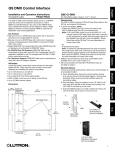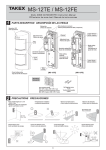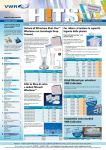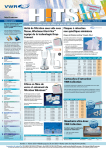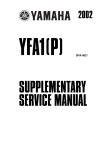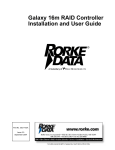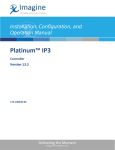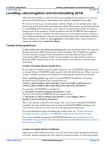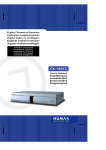Download VIZIO CPU-56 User's Manual
Transcript
EXES-5000 CPU-56 For INTERCOM SYSTEM TOA EXES-5OOO INTERCOM SYSTEM Central Processing Unit CPU-56 INSTALLATION HAND BOOK TOA ELECTRIC CO., LTD. KOBE, JAPAN 133-21-062-2 CONTENTS Page INTRODUCTION TO THE INSTALLATION MANUAL FOR EXES - 5000 3 FUNCTIONS WHICH REQUIRE ADDITIONAL UNITS 4 6 8 TIELINE CONNECTION OF EXCHANGES WIRING FOR TIELINE CONNECTION OF THE EXCHANGES PART 1. Operating of CPU Unit and No. 200 Programming 1. Precautions for Installation of CPU-56 2. Initial CPU-56 set up 10 3. 13 11 Trouble Shooting 4. CPU-56 DIP-Switches for Function Selection 17 5. Function Code Table for Station No. 200 Programming 18 6. Station No. 200 Programming for Each Function 19 < Function Group A > FUNCTION CODE Page Executive Priority 50 19 6-2 Continuous Calling Tone 51 20 6-3 Stations Allowed Access to All Call 52 21 6-4 Stations Allowed Access to Conference 53 22 6-5 Stations Allowed Access to One-shot Make Output 56 23 6-6 Stations Allowed Access to Make/Break Output 57 24 6-7 Stations Allowed Access to 8 Selectable/Decimal Output 58 25 6-8 Stations Allowed Access to 4 Decimal Digits Output 59 26 Secretary Transfer 60 27 6-10 Master/Sub Relationship 61 28 70 29 71 30 72 31 6-14 Group Blocking: Allowing Calls among Groups 81 32 6-15 Group Blocking: Allowing Access to Paging 82 33 6-1 < Function Group B > 6-9 < Function Group C > 6-11 Paging Response 6-12 Group Blocking: Establishment of each Group 6-13 Calling Party Indication < Function Group D > – 1– Page 7. Programming Record for Functions. . . . . . . . . . . . . . . . . . . . . . . . . . . . . . . . . . . . . . . . . . . . 3 4 Function Table for Stations ( 1 ) . . . . . . . . . . . . . . . . . . . . . . . . . . . . . . . . . . . . . . . . . . . . . . . . . . 3 4 Function Table for Stations Function Table for Stations Function Table for Stations ( 2 ) . . . . . . . . . . . . . . . . . . . . . . . . . . . . . . . . . . . . . . . . . . . . . . . . 35 (3)................................................ 36 ( 4 ) . . . . . . . . . . . . . . . . . . . . . . . . . . . . . . . . . . . . . . . . . . . . . . . . . 37 Paging Response Table . . . . . . . . . . . . . . . . . . . . . . . . . . . . . . . . . . . . . . . . . . . . . . . . . . 3 8 3 Examples of Group Blocking . . . . . . . . . . . . . . . . . . . . . . . . . . . . . . . . . . . . . . . . . . . . . . . . 39 — 8. Part 2. Function Selection for Data Transmitting and Receiving Units — Setting Channel Select Switch of Transmitting Unit (DT-E11) and Word Select Switch of Receiving Unit (DR-B61). . . . . . . . . . . . . . . . . . . . . . . . . . . . . . . . . . . . . . . . . . 40 9. DIP Switch Table for Data Transmitting and Receiving U n i t s . . . . . . . . . . . . . . . . . . . . . . . . . . . 4 1 10. System Diagram of Data Transmitting and Receiving Units. . . . . . . . . . . . . . . . . . . . . . . . . . . . . 4 2 11. Explanation of Data Transmitting Unit Output Channels . . . . . . . . . . . . . . . . . . . . . . . . . . . . . . 44 12. Explanation of Data Receiving Unit Output C h a n n e l s . . . . . . . . . . . . . . . . . . . . . . . . . . . . . . . . 45 12-1 CH-0 IN-OUT Annunciation (500 contacts). . . . . . . . . . . . . . . . . . . . . . . . . . . . . . . . . . 45 12-2 CH-1 One-shot Make Output (50 contacts) . . . . . . . . . . . . . . . . . . . . . . . . . . . . . . . . . 46 Make/Break Output (100 contacts). . . . . . . . . . . . . . . . . . . . . . . . . . . . . . . . . . . . 46 8-Selectable Make Outputs (9 Units) . . . . . . . . . . . . . . . . . . . . . . . . . . . . . . . . . . 46 Decimal Output (9 Units) . . . . . . . . . . . . . . . . . . . . . . . . . . . . . . . . . . . . . . . . . . 46 4 Decimal Digits Output (9 Units) . . . . . . . . . . . . . . . . . . . . . . . . . . . . . . . . . . . . . 46 Pager Control Output (64 Contacts). . . . . . . . . . . . . . . . . . . . . . . . . . . . . . . . . . . 46 12-3 CH-2 Calling Party Indication (Lamp) (1) . . . . . . . . . . . . . . . . . . . . . . . . . . . . . . . . . . . . . 47 12-4 CH-3 Calling Party Indication (Lamp) (2). . . . . . . . . . . . . . . . . . . . . . . . . . . . . . . . . . . . . 48 – 2– INTRODUCTION TO THE OPERATION INSTALLATION MANUAL FOR EXES-5000 This manual forms part of the Installation Manual for TOA INTERCOM SYSTEM EXES-5000. You may add the CPU-56 to your TOA INTERCOM SYSTEM EXES-5000, according to your specific needs, to obtain various other functions. Correct operation of these additional functions are not necessarily available only by connection of the additional equipments/devices. Provision of such additional functions requires the following: (1) connection of the additional equipment, as required, (2) selection of functions which satisfy your needs and setting up these functions in the respective equipment For (1) Connections of Equipment, etc., refer to Installation Handbook of Model EX-510/520 EXCHANGE or "Manual for Installation of Data Transmitting and Receiving Units", etc. This "Installation Handbook of CPU-55" deals principally with (2) selection of functions and setting up of respective equipment, There are certain minimum installation requirements to be met; even though you may not need many, of the additional functions or additional equipment, it is still necessary to "2. Initial CPU-56 Set Up (Page 14)". When you use. only some of the additional functions or equipments, it is not necessary to read instructions on the unrequired functions. Make sure, however, that careful study of the necessary parts of this booklet is be done before proceeding further. Note 1; Refer to the Installation handbook of CPU-52A", when installing a standard call and Paging system, using the CPU-52A. Note 2; Refer to respective manuals when other types of CPU and connection equipment/devices are used. INSTALLATION HAND BOOK OF EXES - 5000 EXES - 5000 CPU - 56 INSTALLATION HAND BOOK EXES - 5000 EX-510/520 INSTALLATION HAND BOOK OF EXCHANGE DATA TRANSMITTING AND RECEIVING UNIT Or "DT-E11 OPERATION MANUAL" 133-05-094-1 "DR-B61 OPERATION MANUAL" 133-05-095-0 Or "EXES - 5000 INSTALLATION HAND BOOK (This Hand Book) REQUIRED INSTALLATION HAND BOOK SYSTEMS OF EXES - 5000 EX-510/520 CPU-56 CPU-52A DATA TRANSMITTING AND EXCHANGE RECEIVING UNIT System using CPU-56 System with Display and Control functions using CPU-56 System using CPU-52A – 3– FUNCTIONS WHICH REQUIRE ADDITIONAL UNITS (When the Exchanges are not connected by means of Tie-line.) Those functions of the CPU-56 which require either the addition of specific units or processing in existing units are as mentioned below. Before installation and adjustment of equipment, make sure to check your system. (For Data Transmitting and Receiving units, refer to Part 2. "Function Selection for Data Transmitting and Receiving units" Page 43.) Additional Equipment Required Unit Model Nos. Remarks Talk-Back from paging speaker Talk-Back Unit TKU-11 Optional amplifier (10W max.) may be required depending on application Conference Conference Unit CLU-52 Paging Interface Unit PIU-52/52A External PA Equipment is required. Paging Interface Unit PIU-52/52A 1. Wiring of "Station Paging Assignment Plug" located at the back of the frame of the Exchange. 2. Cutting of LMU jumper wire to split station paging system. (Refer to Service Manual for LMU-52/52A, PIU-52/52A). Paging Interface Unit PIU-52/52A (2 pcs) Output Control Unit OCU-52A Function External PA Paging Station Paging All call plus 15 individual paging zones Data Transmitting and Receiving Units. DT-E11 and DR-B61 Frame FR-510A/B 520A/B Frame FR-510B 520B .. OCU-52 must be modified. (Add M9, M17 and TTL IC 7475 2 pcs.) 2 PIU's can be mounted with terminal for interface output Position of PIU Units for All-Call Paging and 15 Individual Zone Paging CPU - 55 OCU - 52A HCU - 52 SGD-52A CLU-52 DLU-52 LMU - 52A PIU-52/52A No.1 (Zone 0-7 with All-Call Paging) PIU-52/52A No.2 (Zone 8-15 without All-Call Paging) AC POWER INDICATOR LAMP BATTERY POWER INDICATOR LAMP BUZZER STOP SWITCH DS-510A – 4– FUNCTIONS WHICH REQUIRE ADDITIONAL UNITS (When the Exchanges are connected by means of Tie-line.) Those functions of the CPU-56 which require either the addition of specific units or processing in existing units are as mentioned below. Before installation and adjustment of equipment, make sure to check your system. (For Data Transmitting and Receiving units, refer to Part 2. "Function Selection for Data Transmitting and Receiving units" Page 43.) Additional Equipment Required Unit Model Nos. Talk-Back from paging speaker Talk-Back Unit TKU-11 Conference Conference Unit CLU-52 Paging Interface Unit PIU-52/52A External PA Equipment is required. PIU-52/52A 1. Wiring of "Station Paging Assignment Plug" located at the back of the frame of the Exchange. 2. Cutting of LMU jumper wire to split station paging system. (Refer to Service Manual for LMU-52/52A, PIU-52/52A). Function External PA Paging Station Paging Paging Interface Unit Tieline Unit TI-52 Output Unit OCU-52A Remarks Optional amplifier (10W max.) may be required depending on application Turn off the DIP switch for tieline links not used when the exchanges are connected by tielines Tieline connection of exchanges FR-510A/B Frame Data Transmitting and Receiving Units DT-E11 and DR-B61 OCU-52 must be modified. (Add M9, M17 and TTL IC 7475 2 pcs.) PIU-52A and TI-52 can be mounted. 520A/B FR-510B Frame with terminal for interface output 520B CPU - 56 OCU - 52A HCU - 52 SGD - 52A DLU - 52 LMU - 52A TI - 52 PIU-52/52A AC POWER INDICATOR LAMP BATTERY POWER INDICATOR LAMP BUZZER STOP SWITCH DS-550A – 5– TIELINE CONNECTION OF THE EXCHANGES 1. Function of the Central Processing Unit CPU-56 To make communications between exchanges Exchange A Exchange B possible in the EXES-5000 system, the CPU-56 and the Tieline Unit TI-52 are required in addition to the exchange EX-510 or the EX-520. The TI-52 is the interface unit for transmitting and receiving audio signals and dial data signals between the exchanges. Call After receiving dial signals from the station, the CPU-56 transmits the dial data signals to the TI-52 and instructs it to make calls to the other exchange. Station Station The CPU-56 also receives the dial data signals from the other exchange through the TI-52 and calls the station which it is instructed to call by the other exchange. Overall functions of the system using the tieline function are determined by programming made in the CUP-56. – 6– 2. Number of station, paging zones and links Maximum number Composition of exchange(s) of links Number number within of of own ex- exchange paiging change Without Paging zones Without tielines 12 Maximum number of stations Maximum All call 1 16 64 128 56 120 56 120 48 112 112 240 96 224 56 120 48 112 360 144 336 +15zones 2 exchanges All call 1 48 +7zones 12 * 16 * 8 All call 2 +14zones All call 3 exchanges 1 +7zones 12 16 * * All call 3 +21zones 168 * The links within own exchange as well as the tieline links are used in each tieline communication. 3. Numbering for stations and paging zones Numbering for paging zones Numbering for stations Type of exchange with Model Without Paging paging 7 zones per With paging exchange 15 zones per exchange EX-510 200~263 200~255 200~247 Ex-520 200~327 200~319 200~311 Exchange EX-510 "A" (Ex-2A/3A) EX-520 200~247, 256~263 200~247 200~311, 320~327 200~311 Exchange "B" EX-510 470~517, 526~533 470~517 (Ex-2B/3B) EX-520 470~581, 590~597 470~581 Exchange "C" EX-510 740~787, 796~803 740~787 (EX-3C) EX-520 740~851, 860~867 740~851 Single Exchange (EX-1) Paging zone per exchange All call Zone page 0 1~7 01~07 00 08~14 15~21 – 7– Paging 15 zones per exchange All call 00 Zone page 01~15 112 4. Reduction of the number of stations and paging zones which results from the use of the Tieline Unit TI-52. 1. Mounting one (1) piece of the TI-52 decreases the number of the LMU-52A (the 7th or the 15th LMU-52A) by one (1). 2. Unless the PIU-52A is used, the system can have up to 8 more stations by placing an LMU-52A in the 8th or the 16th position. 3. When the system uses the tieline function, the second unit of the PIU-52A (paging zones 8 - 15) cannot be used. Note. LMU:Line Modem Unit PIU:Paging Unit PIUI:Zone No. 0~7 PIU II:Zone No. 8 ~15 TI:Tie line Unit 5. Block diagram for tielined exchanges. Tie line Tie line Exchange A Exchange B Exchange C Note. Tieline connection of EX-510 to EX-520 Exchanges is also possible. – 8– WIRING FOR TIELINE CONNECTION OF THE EXCHANGES Each exchange can be connected by means of a cable with a diameter of 0.65mm for a distance of up to 2km. Regarding the tieline links which are not used, turn off the DIP switch of each unused tieline link inside the Tieline Unit TI-52. Connect "T" line (2 wires) of the 4 wires of each link to "R" line (2 wires) of the other exchange. The 2 wires of the "T" line and "R" line have no polarity. If the BOX-064 is used, its terminals No. 1 and 2 are for the "R" line and No. 3 and 4 are for the "T" line. 1. Wiring for tieline connection of 2 exchanges Exchange A EX-2A Tie line unit TI-52 Exchange B EX-2B Tie line unit TI-52 Note 1. Any combination of tieline links between exchanges "A" and "B" is possible. But, in consideration of possible increase in the number of exchanges to be connected from 2 to 3 in the future, we suggest you connect TL (link No. 0, 1, 2, 3) of exchange "A" to TH (link No. 4, 5, 6, 7) of exchange "B". 2. Wiring for tieline connection of 3 exchanges Exchange A Exchange C Exchange B Note 2. Be sure to connect TL (link No. 0,1,2,3) to TH (link No. 4,5,6,7) between the exchanges. Connection of TH to TH or TL to TL will lead to failure of proper operation of the system. Note 3. Switching arrangements of DIP switches (E-l, E-2, E-3) in the CPU-56 make each exchange to be of "EX-1" or "EX-2A" or "EX-2B" or "EX-3A" or "EX-3B" or "EX-3C" type. – 10 – 3. The Example of connection of 2 EX-520 exchanges (YR-801 must be connected to J15 for EX-520 exchange or to J7 for EX-510 Exchange Terminal board Terminal board BOX-064X2 BOX-064X2 YR-801 for stations YR-801 for stations Exchange A YR-801 for tie-line Exchange The cables between the exchanges YR-80l:Junction cable YR-801 for tie-line Exchange B BOX-064 J7 Exchange A BOX-064 J7 – 11 – B E x c h a n g eA Exchange A BOX-064 J7 YR-801 for tie-line YR-801 for stations Exchange B – 12 – Exchange B BOX-064 J7 YR-801:Junction cable Exchange C BOX-064 J7 YR-801 for tie-line Exchange C YR—801 for stations Terminal board BOX-064X2 The cables between Terminal board BOX-064X2 YR-801 for stations 4.The Example of connection of 3 EX-520 exchanges (YR-801 most be connected to J15 for EX-520 exchange or to J7 for EX-510 exchange) PART 1. OPERATION OF CPU UNIT AND NO. 200 PROGRAMMING 1. PRECAUTIONS FOR INSTALLATION OF CPU-56 Please read the following instructions carefully to ensure proper operation of the CPU-56. 1. Be careful about damage by static electricity as the CPU-56 incorporates CMOS IC's. Do not touch components and connectors. 2. Turn off the AC power switch when you take out or insert the CPU-56 unit, or any other unit. 3. Always insert the CPU-56 unit into the "CPU" slot. Otherwise, there is a danger that the unit will be damaged. 4. Make sure mini-jumper for battery back-up is always placed in the ON position each time it is used. 5. Incorrect setting of function select switches may lead to incorrect performance. 6. Even if you do not need any programming functions, be sure to carry out initial programming and registration at station No. 200 when you install the new unit. Otherwise, other functions may not work properly. 7. The Ni-Cd battery GB50-3FA1 is capable of saving important memory registration data even at times of power failure and we suggest you replace it at least every 4 or 5 years. After the change again set up station No.200 programming of the previous functions in the exchange. 8. When shipping the CPU-56 unit independently, place the mini-jumper for battery back-up in "OFF" position. Then cover CPU back with cardboard, wrap connector section in aluminium foil and put it in a conductive bag. FUNCTION SELECT SWITCHES SW-E (1~6) SW-D ( 1 ~ 6 ) SW-C ( 1 ~ 6 ) SW-B SW-A (1~6) (1~5) These switches select functions. : LINK SELECTION , PAGING AMP. REMOTE "RUN" INDICATIO N Shows the CPU is workin g normally. "SELF RESTART" INDICATION Lights if the CPU self-restarts . PROGRAM SWITC H for #200 Programing Set this to the "ON" position only at time of initial programing of the exchange and registration of functions. In this case, station No. 200 is "programming station" but becomes a normal station when switch is placed in "OFF", position. MINI-JUMPER for battery back-up (JP1) Ni-Cd BATTERY GB50-3FA 1 (3.6V 50mAh) FIXED MINI-JUMPER (JP2 ) – 13 – Note) Do not remove! 2. INITIAL CPU-56 SET UP Make sure that you have turned off the AC power switch. Connect the exchange, terminal boards and stations. Are Data Transmitting and Receiving Units connected ? YES Remove CPU-56 from the exchange. Set mini-jumper, (JP1) for battery from OFF to ON position. Set function selection switches (SW-A ~ SW-E) for required functions. Insert the CPU-56 into the exchange. Put all 4 "link select" switches of the HCU unit upward. (Link No.15) Switch on the exchange. Look at indication of LINE ADDRESS of HCU (14 LEDs) and SIGNAL CODE indication (4 LEDs) All LED lamps are out Memory is normal SIGNAL CODE indication Some errors in memory Lighted lamps of LINE ADDRESS LEDs indicate errorneous MEMORY ICs. See Section 3 (Page13). Place program switch on front panel of the CPU "ON". continue – 14 – 1. Connect Data Transmitting Unit (DT-E11) and Data Receiving Unit (DR-B61). 2. Set channel select switches (CHANNEL SELECT) of DT-E11. 3. Set word select switches (WORD SELECT) of DR-B61. Dial operation from station No. 200. — Initial programming of the exchange — Dial the Following: 1. Dial tone will be heard (Station No.200 becomes a programming station) 2. 10 times 3. 10 times 4. 10 times 5. 10 times 6. 10 times Confirmation tone will be heard. (Clears function group A) Confirmation tone will be heard. (Clears function group B) Confirmation tone will be heard (Clears function group C) Confirmation tone will be heard. (Clears function group D) Confirmation tone will be heard. (Clears personal numbers and single digit dial numbers) Program necessary functions (Refer to separate instructions for each function) Remark: If there is any error in CMOS memory, you hear calling tone instead of confirmation tone. Place program switch on front panel of the CPU in "OFF" position. Dial operation from station No. 200. (Station No. 200 becomes a normal station.) Note 1. When the exchanges are connected by tielines, perform this operation in the CPU-56 unit of all exchanges. Note 2. The programming station of each exchange is as follows: No. 200 (exchange "A") No. 470 (exchange "B") No. 740 (exchange "C") – 15 – 3. TROUBLE SHOOTING 3-1 Check of ROM & NMOS-RAM - No calls on the system. 1. Put the 4 "LINK SELECT" switches of the HCU upward (Link No. 15 SELECT) and switch on the AC power of the exchange. 2. If there is no error, no HCU indication lamps will light. 3. In the event of a memory error, the lamps may light as shown in the example of Fig. 1. 4. The error indications will remain on until you use Link No. 15 for communications. Example Error ROM • RAM Chip No. No.1 and No.2 out of 6 pcs ROMs error. (2716) have a " r e a d " 6543210 No.0 and No.1 out of 4 sets of N-MOS RAMs (2114) have a "read" error. (One set of RAMs consist of 2 ICs) Indicate memory error. LINK SELECT Switches set to select No. 15 3-2 Check of CMOS-RAM (Programmed data memory) At the time of 1. initial programming using station No. 200 and 2. registration of single digit dialing number or personal number made at each station you hear calling tone instead of confirmation tone if there is CMOS memory error. (When the system does not work properly and the CPU unit is considered to be its cause, put the system in the same condition and again operate it using the same CPU to see if the same problems occur again. In the event of error repetition, change the CPU unit for the new one.) 3-3 Fig. 1 HCU indications Indication on front panel of the CPU. "RUN" LED indicator When the system is working normally, LED is "on". Check its condition when the system fails to work normally. "SELF RESTART" LED indicator This does not light when the system is working normally. Even if high noise from outside of the exchange causes the CPU to work abnormally, the CPU "self-restarts" and the system keeps on working normally. Once the CPU "self-restarts", the LED indicator is on, but it does not affect the system. If you again cycle the AC power source, the LED indicator is turned off. – 16 – 3-4. Dial receiving test If you place all "LINK SELECT" switches (1 ~ 4) of SW-A on the CPU-55 in "OFF" position, conversation is impossible but the dial code from each station is indicated on the LED's of the PIU as dialed. Use this to find the cause of any fault of receiving dial information. DIP switches (SW-A of the CPU) PRIVACY PRESS DIGITS DIALED RELEASE (PTT) PRIVACY Fig. 2 ON ON PIU LED No. Fig. 3 Dial code indication 3-4 The order of link usage. After power is on, links are used in numerical order for each communication. Remember this to help you when problems are found with specific links. Remarks: 1. Be sure to avoid mistakes at the time of DIP switch installation and No. 200 Programming since such mistakes may lead to trouble later. 2. Be sure to make "No. 200 Programming" after "Function Registration List" (attached to this manual) is filled out. Keep the finished "Function Registration List" (Initial Checking Sheet for the System 133-21-024-4) as a part of complete drawings for each installation. – 17 – 3-6. The order of Tie Line link usage. The Tieline Link Number which is used in calls between exchanges is not directly indicated, but you can possibly get it from the link number which is indicated on the HCU-52. When one Tieline Link brings up some problems which cause the system not to work properly, try to find which link number is causing the problems from the indication on the HCU-52 of the exchange making the call. As diagram Nol and No2 shows, in the exchanges which make calls, the DLU Link Number corresponds with TI Tieline Link Number. In the exchange which is called,the Tieline Link Number of the TI by connection between exchanges. DLU Links are Unit is fixed used in numerical order. 1. Tieline for 2 exchanges Exchange which is called Exchange which calls Station Which calls No.470 Station which is called Connection Cable between exchanges Diagram 1 2. Tieline for 3 exchanges Exchange which is called Exchange which calls No.470 Station which calls Diagram 2 – 18 – Reference for Connection Link Number between DLU and TI Link Exchange which calls DLU Link No Exchange which is called TI Tieline Link Number Tieline Link Notice: If the TI Tieline Link which correspond with the DLU Link No is already busy, then, the next Tieline Link is automatically used. – 19 – 4. CPU-56 DIP SWITCH FUNCTION SELECTION Functions Switch On Off Activate Not Activate 1 Sec. None Activate Not Activate Link Selection ; Link No. 0 ~ 3 Link Selection ; Link No. 4 ~ 7 SW-A Link Selection ; Link No. 8 ~ 11 Link Selection ; Link No. 12 ~ 15 Time Interval Adjustment Pre-announce tone for Paging Conference Call Transfer Priority & Executive Priority SW-B Paging, Paging During Normal Calls Call Forwarding Activate System Size Selection EX-520 EX-510 Paging Pre-announce Tone Duration Selection 1 Sec. 2 Sec. 15 Individual Paging Zones 15 Zones 7 Zones 2-Digit Dialing (#20 ~ #99) Activate Not Activate Off Off SW-C Off Not Activate * Stations Allowed Access to All Call Stations Allowed Access to Conference Stations Allowed Access to General Purpose Control SW-D Activate Not Activate Activate Not Activate Group Blocking Off General Purpose Control 1xExchange 3xExchange 2xExchange Off Off Off On On On Off On Off On Off On Off Off On Off On On SW-E Pager (64 Contacts Output) Activate Not Activate Activate Not Activate Off Continuous Calling Tone Functions Switch – 20 – On Off D C A Function Group 5. (1/0) 82 Called Group No.(s) (Plural) Paging Group No.(s) (Plural) Paging zone No. of paged group (00~21) (1~8) (l~8) Last Station No. of the Group Last Station No. of the Group Last Station No. of the zone – 21 – Programming 3rd Parameter Calling Group No. (1~8) First Station No. of the Group Group No. (1~8) 72 81 First Station No. of the Group First Station No. of the zone Master Station No. Secretary Station No. ON/OFF Group No. (1~8) Zone No. (01~21) No. Sub Station (1/0) (1/0) ON/OFF (1/0) ON/OFF ON/OFF ON/OFF (1/0) ON/OFF (1/0) ON/OFF (1/0) ON/OFF (1/0) 2nd Parameter 71 70 61 Executive Station No. Station No. (200~327*) (20~99) Station No. (200~327*) (20~99) Station No. (200~327*) (20~99) Station No. (200~327*) (20~99) Station No. (200~327*) (20~99) Station No. (200~327*) (20~99) Station No. (200~327*) (20~99) Station No. (200~327*) (20~99) 1st Parameter * 470~597 in Exchange "B" 740~851 in Exchange "C". Group Blocking: Allowing Access to Paging Zones Group Blocking: Allowing Calls Among Groups Group Blocking: Establishment of each group Paging Response, Paging Priority Master/Sub 60 59 Stations Allowed Access to 4 Decimal Digits Output Secretary Transfer 58 57 56 53 52 51 50 Function Code Stations Allowed Access to 8 Selectable/Decimal Output Stations Allowed Access to Make/ Break Output Stations Allowed Access to One Shot Make Output Stations Allowed Access to Conference Stations Allowed Access to All Call Continuous Calling Tone Executive Priority Function Function Code Table for Station No.200 Confirmation tone Confirmation tone OPERATING FOR PROGRAMMING 6. STATION NO. 200 PROGRAMMING FOR EACH FUNCTION 6-1 EXECUTIVE PRIORITY (FUNCTION CODE 50) EXECUTIVE PRIORITY Step 1 Touch Function Code New Registration ? Executive Station No. ON Touch Executive Station No. ON Touch Confirmation tone NO New Registration finished ? YES Release ? Executive Station No. OFF Touch Executive Station No. OFF Touch Confirmation tone Release finished ? Return NOTES 1. To register all stations at one time, 3. Re-start at Step 1 when mis-dialing occurs. Touch (All other registrations remain valid.) 10 times 4. Station No. should be 2 digits in length when 2 Digit (Confirmation tone will be heard.) Dialing function is employed. 2. To release all registered stations at one time, 5. CPU DIP switch B-3 must be "ON" to employ this Touch function. 10 times (Confirmation tone will be heard.) – 22 – 6-2 CONTINUOUS CALLING TONE (FUNCTION CODE 51) CONTINUOUS CALLING TONE Step 1 Touch Function Code New Registration ? Continuously Called Station No. ON Touch Continuously Called Station No. ON Touch Confirmation tone New Registration finished ? Release ? Continuously Called Station No. OFF Touch Continuously Called Station No. OFF Touch Confirmation tone Release finished ? Return NOTES 1. To register all stations at one time, 3. Re-start at Step 1 when mis-dialing occurs. (All other registrations remain valid.) Touch 10 times 4. Station No. should be 2 digits in length, when 2 Digit (Confirmation tone will be heard.) Dialing function is employed. 2. To release all registered stations at one time, 5. CPU DIP switch E-6 must be "ON" to employ this Touch function. 10 times (Confirmation tone will be heard.) – 23 – 6-3 STATIONS ALLOWED ACCESS TO ALL CALL (FUNCTION CODE 52) STATIONS ALLOWED ACCESS TO ALL CALL Step 1 Touch Function Code New Registration ? Allowed Station No. ON Touch Allowed Station No. ON Touch Confirmation tone New Registration finished ? Release ? Allowed Station No. OFF Touch Allowed Station No. OFF Touch Confirmation tone Release finished ? Return NOTES 1. To register all stations at one time, 3. Re-start at Step 1 when mis-dialing occurs. (All other registrations remain valid.) Touch 10 times 4. Station No. should be 2 digits in length, when 2 Digit (Confirmation tone will be heard.) Dialing function is employed. 2. To release all registered stations at one time, 5. Programming is necessary only if CPU DIP switch D-1 is "ON". Touch 10 times (Confirmation tone will be heard.) – 24 – 6-4 STATIONS ALLOWED ACCESS TO CONFERENCE (FUNCTION CODE 53) STATIONS ALLOWED ACCESS TO CONFERENCE Touch Function Code New Registration ? Allowed Station No. ON Touch Allowed Station No. ON Touch Confirmation tone New Registration finished ? Release ? Allowed Station No. OFF Touch Allowed Station No. OFF Touch Confirmation tone Release finished ? Return NOTES 1. To register all stations at one time, 3. Re-start at Step 1 when mis-dialing occurs. (All other registrations remain valid.) Touch 10 times 4. Station No. should be 2 digits in length when 2 Digit (Confirmation tone will be heard.) Dialing function is employed. 2. To release all registered stations at one time, 5. Programming is necessary only Touch if CPU DIP switch D-2 is "ON". Switch B-1 must be "ON" to employ 10 times this function. (Confirmation tone will be heard.) – 25 – 6-5 STATIONS ALLOWED ACCESS TO ONE SHOT MAKE OUTPUT (FUNCTION CODE 56) STATION ALLOWED ACCESS TO ONE SHOT MAKE OUTPUT Step 1 Touch Function Code New Registration ? Allowed Station No. ON Touch Allowed Station No. ON Touch Confirmation tone New Registration finished ? Release ? Allowed Station No. OFF Touch Allowed Station No. OFF Touch Confirmation tone Release finished ? Return NOTES 3. Re-start at Step 1 when mis-dialing occurs. 1. To register all stations at one time, (All other registrations remain valid.) Touch 10 times 4. Station No. should be 2 digits in length when 2 Digit (Confirmation tone will be heard.) Dialing function is employed. 2. To release all registered stations at one time, 5. Programming is necessary only Touch if CPU DIP switch D-3 is"ON". Switch D-6 must be "ON" to employ 10 times this function. (Confirmation tone will be heard.) – 26 – 6-6 STATIONS ALLOWED ACCESS TO MAKE/BREAK OUTPUT (FUNCTION CODE 57) STATIONS ALLOWED ACCESS TO MAKE/BREAK OUTPUT Step 1 Touch Function Code New Registration ? Allowed Station No. ON Touch Allowed Station No. ON Touch Confirmation tone New Registration finished ? Release ? Allowed Station No. OFF Touch Allowed Station No. OFF Touch Confirmation tone Release finished ? Return NOTES 1. To register all stations at one time, 3. Re-start at Step 1 when mis-dialing occurs. Touch (All other registrations remain valid.) 10 times 4. Station No. should be 2 digits in length when 2 Digit (Confirmation tone will be heard.) Dialing function is employed. 2. To release all registered stations at one time, 5. Programming is necessary Touch D-3 is "ON". Switch D-6 10 times this function. (Confirmation tone will be heard.) – 27 – only if CPU DIP switch must be "ON" to employ 6-7 STATIONS ALLOWED ACCESS TO 8 SELECTABLE (OR DECIMAL) OUTPUT (FUNCTION CODE 58) STATIONS ALLOWED ACCESS TO 8 SELECTABLE (OR DECIMAL) OUTPUT Step 1 Touch Function Code New Registration ? Allowed Station No. ON Touch Allowed Station No. ON Touch Confirmation tone New Registration finished ? Release ? Allowed Station No. OFF Touch Allowed Station No. OFF Touch Confirmation tone Release finished ? Return NOTES 3. Re-start at Step 1 when mis-dialing occurs. 1. To register all stations at one time, (All other registrations remain valid.) Touch 10 times 4. Station No. should be 2 digits in length when 2 Digit (Confirmation tone will be heard.) Dialing function is employed. 2. To release all registered stations at one time, 5. Programming is necessary Touch only if CPU DIP switch D-3 is "ON". Switch D-6 must be "ON" to employ 10 times this function. (Confirmation tone will be heard.) – 28 – 6-8 STATIONS ALLOWED ACCESS TO 4 DECIMAL DIGITS OUTPUT (FUNCTION CODE 59) STATIONS ALLOWED ACCESS TO 4 DECIMAL DIGITS OUTPUT Step 1 Touch Function Code New Registration ? Allowed Station No. ON Touch Allowed Station No. ON Touch Confirmation tone New Registration finished ? Release ? Allowed Station No. OFF Touch Allowed Station No. OFF Touch Confirmation tone Release finished ? Return NOTES 3. Re-start at Step 1 when mis-dialing occurs. 1. To register all stations at one time, (All other registrations remain valid.) Touch 10 times 4. Station No. should be 2 digits in length when 2 Digit (Confirmation tone will be heard.) Dialing function is employed. 2. To release all registered stations at one time, 5. Programming is necessary Touch only if CPU DIP switch D-3 is "ON". Switch D-6 must be "ON" to employ this function. 10 times (Confirmation tone will be heard.) – 29 – 6-9 SECRETARY TRANSFER (FUNCTION CODE 60) Registration of Call Forwarding SECRETARY TRANSFER Step 1 Touch Function Code New Registration ? Executive Station No. Secretary Station No. Touch Executive Station No. Secretary Station No. Touch Confirmation tone New Registration finished ? Release ? Executive Station No. Executive Station No. Touch Executive Station No. Executive Station No. Touch Confirmation tone Release finished ? Return NOTES 3) Station No. should be 2 digits in length when 2 Digit 1. To release all registered stations at one time, Dialing function is employed. Touch 10 times (Confirmation tone will be heard.) 4) Employment of Call Forwarding function makes the Secretary's station to be the station the call is to be rerouted to when the station called first is busy. 2) Re-start at Step 1 when mis-dialing occurs. (All other registrations remain valid.) – 30 – 6-10 MASTER/SUB RELATIONSHIP (FUNCTION CODE 61) MASTER/SUB RELATIONSHIP Step 1 Touch Function Code New Registration ? Sub Station No. Master Station No. Touch Sub Station No. Master Station No. Touch Confirmation tone New Registration finished ? Release ? Sub Station No. Sub Station No. Touch Sub Station No. Sub Station No. Touch Confirmation tone Release finished ? Return NOTES 3. Station No. should be 2 digits in length when 2 Digit 1. To release all registered stations at one time, Dialing function is employed. Touch 10 times (Confirmation tone will be heard.) 2. Re-start at Step 1 when mis-dialing occurs. (All other registrations remain valid.) – 31 – 6-11 PAGING RESPONSE (FUNCTION CODE 70) PAGING RESPONSE Step 1 Touch Function Code Paging Zone No. (01 ~ 15) Paging Zone No. (01 ~ 15) 1st Station No. Last Station No. of the Zone of the Zone 1st Station No. Last Station No. of the Zone of the Zone Confirmation tone New Registration finished ? Return NOTES 3. Station No. should be 2 digits in length when 2 Digit 1. To release all registered Zones at one time, Dialing function is employed. Touch 10 times 4. Switch B-4 must be "ON" to employ this function. (Confirmation tone will be heard.) 2. Re-start at Step 1 when mis-dialing occurs. (All other registrations remain valid.) – 32 – 6-12 GROUP BLOCKING ; ESTABLISHING GROUPS (FUNCTION CODE 71) GROUP BLOCKING 1 ESTABLISHMENT OF EACH GROUP Step 1 Touch Function Code Group No. (1 ~ 8) 1st Station No. of the Group Last Station No. of the Group Group No. (1 ~ 8) 1st Station No. of the Group Last Station No. of the Group Touch Touch Confirmation tone New Registration finished ? Return NOTES 3. Station No. should be 2 digits in length when 2 Digit 1. To release all registered Zones at one time, Dialing function is employed. Touch 10 times 4. CPU DIP switch D-4 must (Confirmation tone will be heard.) be "ON" to employ this function. 2. Re-start at Step 1 when mis-dialing occurs. 5. Group No.7 and 8 are not needed the programming in case the exchanges are tielined. (All other registrations remain valid.) – 33 – 6-13 THE GROUPS OF STATIONS FOR CALLING PARTY INDICATION (Lamp Type). (FUNCTION CODE 72) ESTABLISHMENT OF EACH GROUP Step 1 Touch Function Code Group No. (1 ~ 8) 1st Station No. of the Group Last Station No. of the Group Group No. (1 ~ 8) 1st Station No. of the Group Last Station No. of the Group Touch Touch Confirmation tone New Registration finished ? Return NOTES 1. To release all registered Groups at one time, 3. Station No. should be 2 digits in length when 2 Digit Dialing function is employed. Touch 10 times (Confirmation tone will be heard.) 2. Re-start at Step 1 when mis-dialing occurs. (All other registrations remain valid.) – 34 – 6-14 GROUP BLOCKING ; ALLOWING CALLS AMONG GROUPS (FUNCTION CODE 81) GROUP BLOCKING 2 ALLOWING CALLS AMONG GROUPS Step 1 Touch Function Code New Registration ? Calling Group No. (1 ~ 8) Called Group No. (s) (max. 7) Calling Group No. (1 ~ 8) Called Group No. (s) (max. 7) Touch Touch Confirmation tone New Registration finished ? Release Calling Group No. (1 ~ 8) Touch Calling Group No. (1 ~ 8) Touch Confirmation tone Release finished ? Return NOTES 1. To release all registered Calling Groups at one time, 3. Do not register a Group to call itself. This cancels calling ability to other groups. Touch 4. CPU DIP switch D-4 must be "ON" to employ this 10 times function. (Confirmation tone will be heard.) 5. Group No.8 is not needed in case 2 exchanges are tielined. 2. Re-start at Step 1 when mis-dialing occurs (All other registrations remain valid.) – 35 – 6-15 GROUP BLOCKING ; ALLOWING GROUP ACCESS TO PAGING ZONES (FUNCTION CODE 82) GROUP BLOCKING 3 ALLOWING ACCESS TO PAGING ZONES Step 1 Touch Function Code New Registration ? Paging Group No. (S) ( 1 ~ 8 ) (max. 8) Paging Zone Touch (00~21) Paging Group No. (S) ( 1 ~ 8 ) (max. 8) Touch Confirmation tone New Registration finished ? Release ? Touch Touch Confirmation tone Release finished ? Return 2. Re-start at Step 1 when mis-dialing occurs NOTES (All other registrations remain valid.) 1. To release all registered Paging Zones at one time, Touch 3. CPU DIP switch D-4 must be "ON" to employ this 10 times function. (Confirmation tone will be heard.) 4. Group No.7 and 8 are not needed the programming in case the exchanges are tielined. – 36 – Name – 37 – Group No. for Calling Party Indication B Group No. for Group Blocking Paging Zone No. A Master Station No. Stations Allowed Access to 4 Decimal Digits Output Stations Allowed Access to 1/8 Select (or Decimal) Output Stations Allowed Access to Make/Break Output Function Group Stations Allowed Access to One Shot Make Output Stations Allowed Access to Conference Stations Allowed Access to All Call Continuous Calling Tone Executive Priority Station No. Function Function Code 7. PROGRAMMING RECORD FOR FUNCTIONS Use these tables to keep a record of those functions assigned to each station. Function Table for Stations (1) C Continuous Calling Tone Stations Allowed Access to All Call Stations Allowed Access to Conference Stations Allowed Access to One Shot Make Output Stations Allowed Access to Make/Break Output Stations Allowed Access to 1/8 Select (or Decimal) Output Stations Allowed Access to 4 Decimal Digits Output Name Executive Priority Station No. Function Function Code – 38 – 50 51 52 53 56 57 58 59 60 61 70 71 Group No. for Calling Party Indication B Group No. for Group Blocking A Paging Zone No. Function Group Master Station No. Function Table for Stations (2) C 72 Continuous Calling Tone Stations Allowed Access to All Call Stations Allowed Access to Conference Stations Allowed Access to One Shot Make Output Stations Allowed Access to Make/Break Output Stations Allowed Access to 1/8 Select (or Decimal) Output Stations Allowed Access to 4 Decimal Digits Output Name Executive Priority Station No. Function Function Code – 39 – 50 51 52 53 56 57 58 59 60 61 70 71 Group No. for Calling Party Indication B Group No. for Group Blocking A Paging Zone No. Function Group Master Station No. Function Table for Stations (3) C 72 Continuous Calling Tone Stations Allowed Access to All Call Stations Allowed Access to Conference Stations Allowed Access to One Shot Make Output Stations Allowed Access to Make/Break Output Stations Allowed Access to 1/8 Select (or Decimal) Output Stations Allowed Access to 4 Decimal Digits Output Name Executive Priority Station No. Function Function Code 50 51 52 53 56 57 58 59 – 40 – 60 B 61 70 71 Group No. for calling Party Indication Group No. for Group Blocking A Paging Zone No. Function Group Master Station No. Function Table for Stations (4) C 72 Paging Response Table < When a single exchange is used > No. Department 1st Station No. Last Station No. 1 X PIU-52A Station Paging Zone 01 02 03 04 2 X PIU-52A Function Code 70 05 06 07 08 09 10 11 12 13 14 15 < When the exchanges are connected by tielines > Station Paging Zone Function Code 70 Department type of exchange A 01 02 03 04 09 05 12 06 13 07 14 1st Station No. Last Station No. C B 08 10 17 11 20 21 Station numbers for Calling Party Indication (Lamp Type) Calling Party Indication Name Group No. 1st Station No. Function Code 72 1 2 3 4 5 6 7 8 – 41 – Last Station No. Tables for Group Blocking 1 Only when the exchange without tieline. 2 Not used when 2 exchanges are tielined. Activated without No.200 programming. – 42 – PART 2. FUNCTION SELECTION FOR DATA TRANSMITTING AND RECEIVING UNITS 8. SETTING CHANNEL SELECT SWITCHES OF TRANSMITTING UNITS (DT-E11) AND WORD SELECT SWITCH OF RECEIVING UNITS (DR-B61) NOTE set the channel select switches located on the printed 1. Connect the DT-E11 and DR-B61 to Exchange correctly. (Refer to installation manuals of DT-E11 and DR-B61.) circuit board, according to the necessary functions such as IN/OUT Annunciation, Calling Party Indication etc, and replace in the Unit. 2. Set the function select switches (DIP SWITCH) on (Refer to 12. Explanation of Data Transmitting Unit Output Channels, Page 39). CPU-55 correctly and be sure to enter initial programming and function registration at programming station No. 200. 4. The DT-E11 sends out 512 bit data (16 bit x 32 words) to control relays on Data Receiving Unit (DR-B61). Therefore set the two word select switches on DR-B61, 3. Remove the front panel of Data Transmitting Unit (DT-E11) and take out the printed circuit board. Then according to necessary output mode. SW-1 is for Relay No.1 to No.16 and SW-2 is for Relay No.17 to No. 32. See Page 41 for details. (Refer to Explanation of Data Receiving Unit Output Channels.) Connecting Relay Number Cable YR-802 Connecting Cable YR-803 To other DR-B61 To other DT-E11 CHANNEL SELECT Switch (SW-1) To other DR-B61 – 43 – WORD SELECT Switch (SW-1, SW-2) 9 . DIP SWITCH TABLE FOR DATA TRANSMITTING AND RECEIVING UNIT Exchange Data Transmitter Data Receiver – 44 – Relay Output No. 10. System Diagram of Data Transmitting and Receiving Units (When the Exchanges are not connected by means of Tie-line.) Exchange Stations YR-801 YR-802 < Data Receiver (Equipment using DR-B61) > Data Transmitting Unit In/Out Annunciation Display Board YR-803 One-shot-Make Output (50 contacts) Prescription Display Board, etc. Make-Break Output (100 contacts) 8 Selectable Make Output (9 Units) c. Section Chief, a. President. b. Department Chief, d. Chief Clerk Room Condition Indication. Destination Indication, etc. Decimal Output (9 Units) YR-803 Prescription Display Board, etc. 4 Decimal Digits Output (9 Units) Pager Control 6 (4 pager) Calling Party Indication. Lamp Type (1) YR-803 Calling Party Indication. Lamp Type (2) Power supply DC 24V – 45 – System Diagram of Data Transmitting and Receiving Units – 46 – (When the Exchanges are connected by means of Tie-line.) 11. EXPLANATION OF DATA TRANSMITTING UNIT OUTPUT CHANNELS CHANNEL SELECT FUNCTIONS DESCRIPTION APPLICATION Personel in and put registration can be accomplished at any Master sta- CH. 0 IN/OUT Annunciation tion by using personal numbers Max. IN/OUT Annunciation 500 IN/OUT annunciations may be done. One-shot Make Output Make/Break Output 8 Selectable Make Output 50 One-shot make contacts can be ITV camera select available at any Master station. VTR control 100 Door Remote Make/Break contacts can be available at any Master station. IN/OUT Annunciation One contact out of 8 selectable make Destination indication output is obtained. CH. 1 Decimal Output (9 unit blocks) 4 Decimal digits output 10 Selectable Decimal Outputs are Room condition indication. available with 7 segments LEDs. Indicate by 7 segments LEDs. Prescription annunciation Make output (64 contacts) are Pager (9 unit blocks) Pager Control Output available for pager control. Calling Party Indication CH. 2 (One Station; One Lamp) Max. 128 Calling station numbers can be indicated when designated called The number of called stations are No. XXX ~ No. XXX station with Display Board is called. CH. 3 Calling Party Indication (One Station; One Lamp) Same as above except called station The number of called stations number are No. XXX ~ No. XXX – 47 – 12. EXPLANATION OF DATA RECEIVING UNIT OUTPUT CHANNELS 12-1 Channel 0 (CH. 0) In/Out Annunciation (Dial Operation) Personal Number Registration Exchange Personal Number Cancellation Data Transmitter Data Receiver Each Relay Output shows last 3 digits (xxx) of Personal Number – 48 – (Relay Make) XXX: 000 ~ 499 (500 contacts) (Relay Break) Relay Output No. 12-2 Channel 1 (CH. 1) (2) Make/Break Output (1) One-shot Make Output (3) 8 Selectable Make Output Exchange Data Transmitter (6) Pager Control Output Relay Output No. Data Receiver CHANNEL SELECT Switch One-shot Make Output One-shot Make Output (5) 4 Decimal digits output (9 unit blocks) (4) Decimal Output (9 unit blocks) 3 Selectable make Output Make/Break Output Make/Break Output 8 Selectable Make Output Unit No. 4 Condition "0" Unit No. 6 Condition "7" Decimal Output (9 unit blocks) Decimal Output (9 unit blocks) Binary Negative Logic Output 4 Decimal digits output (9 unit blocks) 4 Decimal digits output (9 unit blocks) Binary Output Negative Logic Pager Control Output Pager Control Output Pager No. Note: shows the Head of a Slide Switch – 49 – 12-3 Channel 2 (CH. 2) Calling Party Indication Lamp Type (1) Each "Calling Station" or "Waiting Station" is shown by Each Indication Lamp. Exchange Data Transmitter Total Number of Stations with Indications : 4 Stations/Channel (8 Stations/2 Channels) Total Number of Calling Stations : Max. 128 Stations/Each Indication Relay Output No. Data Receiver Each Relay Output shows "Calling Station No." – 50 – 12-4 Channel 3 (CH. 3) Calling Party Indication Exchange Data Transmitter Lamp Type (2) Each "Calling Station" or "Waiting Station" is shown by Each Indication: Lamp. Total Number of Station with Indications : 4 Stations/Channel (8 Stations/2 Channels) Total Number of Calling Stations : Max. 128 Stations/Each Indication Data Receiver Each Relay Output shows "Calling Station No." – 51 – Relay Output No. TOA ELECTRIC CO., LTD. KOBE, JAPAN Printed in Japan























































